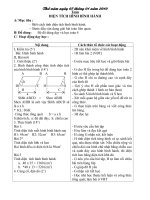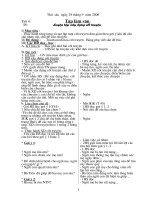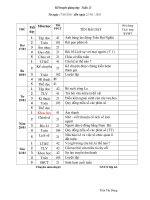Bài giảng topic 4 production costs
Bạn đang xem bản rút gọn của tài liệu. Xem và tải ngay bản đầy đủ của tài liệu tại đây (344.05 KB, 39 trang )
Topic 4
Production and Costs
PRODUCTION & COSTS
1. Production & Costs concepts
2. Short run Costs
3. Long Run Costs
1. Some cost concepts
Opportunity Cost
Opportunity cost:
The benefit foregone, or opportunity lost, by not using resources in their best
alternative use
Real Opportunity cost:
Maximum quantity of output forgone
Money Opportunity cost
Maximum value of output forgone
1. Some cost concepts
Explicit Vs. Implicit Cost
Explicit costs
what we actually pay for use of resources in
business
Implicit costs
opportunity costs of resources used but not
actually paid for by the firm (eg. proprietor's
labour)
1. Profit concepts
Accounting profit
=Total revenue – Total Explicit costs
Economic profit
= Total revenue – (Total Explicit costs + Total Implicit costs)
= Total revenue – Opportunity costs of all resources used
Normal profit
= Zero Economic profit or breaking even
= The minimum cost payment just sufficient to keep the firm
in business
Exercise
Bill runs a computer shop as a sole proprietorship. The following
data are about his financial matters in his first year of business.
Calculate Bill's accounting profit and economic profit for his first year of
business.
$
$
190,000 Total revenue
65,000 Salary that Bill could have earned if he had worked for
another firm
90,000 Loan from a bank
9,000 Interest paid to the bank
70,000 Purchase of durable assets with his own money
4,200 Dividend that he could have earned by investing his
$70,000 in shares
14,000 Depreciation of the durable assets
30,000 Salary for an assistant
67,000 Raw materials used
1. Short- Run Vs Long-Run
Short run
the time frame in which
at least one input factor is fixed
Long run
the time frame in which
all input factors are variable
There is no fixed calendar definition of long or short run– it
depends!
2. Short Run Production
Assume all factors fixed, except labour
Average Product of labour (AP
L
) is the total
product output per unit of labour
where: Q is the total product output
L is no. of labour units
2. Short Run Production
Marginal product of labour (MP
L
) is the
additional product output resulting from
an extra unit of labour
∆Q is the change in product output
∆L is no. of units of labour
TP = Q = Total product or Total output
Wheat production per year from a
particular farm (tonnes)
Copyright 2001 Pearson Education
Australia
Law of Diminishing
Returns
" as successive units of a variable resource
(say, labor) are added to a fixed resource
(say, land), beyond some point the marginal
product (MP) attributable to each additional
unit of the variable resource will decline."
(Jackson, p.228)
Law of Diminishing
Returns
Assuming…
A variable resource (labour) is added to set of fixed resources (plants and
machinery)
technology is given
Law of Diminishing
Returns
As units of a variable resource are added to
a set of fixed resource, with technology
constant, the marginal product of the
variable resource must eventually diminish.
That is, when the optimal combination
between labour and fixed resources has
been reached, any further addition of labour
means that each worker will have less and
less of the plants & machinery to work with,
and so they must become less and less
efficient.
fig
Tonnes of wheat per year
TP
Tonnes of wheat per year
MP
Number of
farm workers (L)
Number of
farm workers (L)
Wheat production per year from a particular farm
Copyright 2001 Pearson Education
Australia
fig
Tonnes of wheat per year
TPP
Tonnes of wheat per year
MPP
b
Diminishing returns
set in here
Number of
farm workers (L)
Number of
farm workers (L)
b
Wheat production per year from a particular farm
Copyright 2001 Pearson Education
Australia
fig
Tonnes of wheat per year
TP
Tonnes of wheat per year
MP
b
d
d
Number of
farm workers (L)
Number of
farm workers (L)
Maximum
output
b
Wheat production per year from a particular farm
Copyright 2001 Pearson Education
Australia
The Production Curves
MP cuts through AP at
the maximum AP
When marginal >
average, average is
increasing
When marginal falls
below average, average
starts falling too.
When MP > 0, TP
increasing
When MP < 0, TP
decreasing
When MP = 0, TP is at
its maximum
To practice what we’ve done
so far…
Short run Costs
Total Costs
Total Fixed Cost TFC
Total Variable Cost TVC
Total Cost TC = TFC + TVC
Average Costs
Average fixed cost (AFC) = TFC/Q
Average Variable cost (AVC) = TVC/Q
Average Total cost (ATC) = TC/Q = AFC+AVC
Short-run Costs
Quantity
Costs (dollars)
TC
Total
Cost
Fixed Cost
TVC
Variable Cost
TFC
Short run Costs
Marginal Cost (MC) is the extra cost of producing one more unit of a product
MC = ∆TC / ∆Q
MC = ∆TVC / ∆Q
Marginal Cost Relationships
When MC < ATC
ATC falls
When MC > ATC
ATC increases
When ATC = MC
ATC is at its minimum
Cost Relationships
Relationship b/w
TVC, TFC & TC
MC cuts both AVC & ATC at
their minimum points
AFC is
decreasing
2.To practice what we’ve done
so far…
Review Question 2, 3 pp 15, 16
3. LONG-RUN THEORY OF
PRODUCTION
In the long run All factors of production are variable









